

I have always felt the EK3 Civic to be one of Honda's best overall Civic models. For its market segment and design objectives, it easily ranks alongside the excellence level of the EK4 Si/SiRs and even the EK9 Type-R. Even against the lastest ES2 Civic Ferio RS, the EK3 Civic still show-cases some unique technologies that have rather unfortunately been removed in the Civic RS. I decided to do this series on the 'Executive' EK3 Civics to show-case the unique technologies that it possesses, using two of my older articles to start it off; the one on the D15B engine and the english translation of the Honda Japan web-site's technical article on the state of the art Multimatic transmission. This is followed by TOVA reader Evan's article about his EK3 Civic VTi hatch. While many knows about Honda's Multimatic, few are fortunate to have experience of its usage so I next did a coverage on the Multimatic Driving Experience. Now in this article, I focus on what I feel to be the best overall mid-sized sedan Honda have yet made, the EK3 Civic Ferio Vi.

For the EK-generation Civics, Honda used the model code EK3 to denote the 'executive' Civic versions. As I wrote in the D15B article what I call 'executive' versions are effectively '2nd from the top' Civics, in this case, just below the top B16A and B16B engined variants. Executive Civics are powered by engines with a balance of fuel economy and power and designed for practicality and comfort unlike the B16A & B16B engined Civics which focuses purely on performance to the extent of compromising rather large degrees of comfort and even practicality.
"2nd from the top" Civics relies on the D15B engine in various configurations. The D15B displaces 1493c.c. and is always SOHC in design. In the EK3 series of variants, Honda equipped it with either just plain PGM-Fi which produces 105ps or the now famous 3-stage VTEC mechanism in which case it produces 130ps but with fuel consumption that can reach up to ~28km/l ! With the EK-generation, Honda also continued with the segregation of using the Civic name for the 3-door hatchbacks and Civic Ferio for the 4-door sedans. However, in addition to this Honda also used different type nomenclatures for the hatch and sedans.
Thus in the EK-generation, we now have two line-ups of the executive Civics. The D15B SOHC PGM-Fi (105ps) versions are now Civic Ri and Civic Ferio Mi while the D15B 3-stage VTEC (130ps) versions are Civic VTi and Civic Ferio Vi. All of them are coded E-EK3. The ones you want are of course either the Civic VTi or if you're a more family oriented man with domestic requirements, the Civic Ferio Vi. Both represent probably the one of the best overall small sedans ever made.
 |
| The cover don't say it but the engine's definitely a VTEC ! |
The first VTEC-D15B used on the EG-Civics has attractive black crinkled painted valve covers. But since then, Honda have been continously simplifying the engine valve covers. In late production EG-Civics, the black covers were replaced by plain metal covers though still with the casted VTEC word. For the 3-stage VTEC D15Bs on the EK3s however, Honda removed the VTEC word and replaced it with a single 'Honda' word. This move have actually caught many people by surprise - ignorant ones even confidently tell people that EK3s are always non-VTEC and only EK4s are 'VTEC Civics'. And the proof they say is because the valve cover doesn't have the VTEC word !
The non-VTEC D15B and the 3-stage VTEC D15B on the EK3s are actually very different designs. The regular D15B has a top mounted air-filter box, with the throttle body mouth facing upwards. Therefore, the non-VTEC D15B engine has the air-filter box very prominently on top. The 1.6l SOHC engines used on various Asian versions of the EK-Civics looks similar to the 3-stage VTEC D15B however - the 1.6l SOHC-VTEC used in Malaysian even has black crinkled valve covers with the VTEC word. So, how do one confirm that an engine is a 3-stage VTEC D15B ?
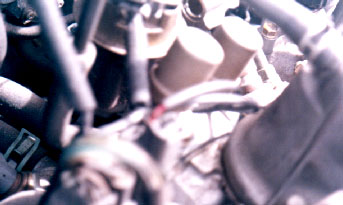 |
| Look, 2 VTEC soleniods ! After all, this is a 3-stage VTEC |
Well, there are a number of ways to confirm. The most obvious and certain ones are of course the VTEC solenoids. Yes, solenoids, with the 's' because the 3-stage VTEC will have two of them. If I am not mistaken, the 3-stage VTEC D15B is the only Honda engine with two VTEC solenoids. One is for transition from 'stage-1' (12 valve) to 'stage-2' (16 valve 'mild' cams) and the other for transition from 'stage 2' to 'stage 3' (16 valve 'wild' intake cams). As explained, for the SOHC engines, the VTEC solenoids are not located beside the distributor but just on top of the intake runners. The photo on the right shows the two VTEC solenoids very clearly.
 |
|
The famous "ECONO" LED Note how high's that red-line on the tacho |
The 3-stage VTEC D15B has other technological advances that the plain non-VTEC D15B and indeed many other Honda engines doesn't have. The 3-stage VTEC D15B has the ability to operate in lean-burn mode. Lean-burn mode indicates the engine is running at a super lean air/fuel ratio of around 20:1 !! Normal engines would probably have detonated itself to pieces way before getting anywhere near this ratio but the 3-stage VTEC D15B exploits the 12V mode to acheive this. In 12V lean-burn mode, only 1 intake valve opens during the intake stroke and this causes the air to swirl into the combustion chamber. This swirling promotes a very complete mixing of the air/fuel mixture and with other design innovations, Honda is able to run the 3-stage VTEC D15B at ~20:1 a/f ratio under ideal conditions (very light throttle, level road, etc). Lean-burn mode on the Civic VTi and Civic Ferio Vi are indicated by the lighting up of a green LED on the dashboard with the word "econo" on it. Actually, the 3-stage VTEC D15B is the only Civic engine in Honda's history so far to have this LED feature. For the person who values economy, it is a fantastic way to monitor fuel consumption. Everytime the ECONO led lights up, it means lean-burn mode and the engine is running at ~20:1 a/f ratio. Sustain this and fuel economy will approach 28km/l ! With careful and sensible driving styles, it is often possible to maintain this mode for a surprisingly large part of an ordinary journey. The beauty is that even if there is a need to overtake the car in front, lean-burn mode can be re-entered again almost immediately after the manuveure !
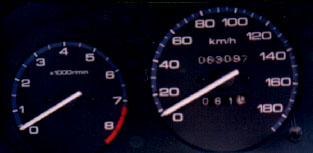 |
|
A 7200rpm red-line and ~20l/km mileage Impossible ? Not for Honda's 3-Stage VTEC ! |
VTEC engines are of course also reknown for their ability to rev to high rpms. Actually this is not really due to VTEC per-se but rather that VTEC enables the application of race technologies in everyday engines. And naturally-aspirated race-engines relies heavily on high revs for power. The 3-stage VTEC D15B red-lines at a very high 7200rpm, a redline acheiveable by few engines even today. Thus the Civic Ri and Civic Ferio Mi (as well as 1.6l SOHC non-VTEC and VTEC engined Civics) have tachometers with red-lines at 6800rpm while the Civic VTi and Civic Ferio Vi will have tachometers with red-lines at 7200rpm. One can imagine just how much technologies have gone into this unassuming, mild looking yet amazing engine. On the one hand, race-technologies have given us a 7200rpm red-line - way above many cars with claims to being "performance" or "sporty", with race-like wild cam profiles and the induction roar of a performance tuned engine. Then on the other hand, the same little engine will happily putter along at below 2000rpm for speeds up to 70-80kph and at the same time running at a hereto unheard of ~20:1 air-fuel ratio ! This 3-stage VTEC D15B gives us 130ps, a power output range more commonly associated with larger engines as well as mileage of 13 - 14 km/l or more for in-town driving, even higher for long distance journeys - fuel consumptions more commonly associated with small engined economy cars. All this in a roomy, medium sized executive sedan !

EK3 Civic Ferio Vi's are best appreciated with Honda's wonder Multimatic CVT transmission. Driving a Multimatic Civic gives an entirely new and wonderful experience. For the uninitiated, first impressions can be a surprise because of the MMT's ability to maintain optimum gearing at any speed.
In the previous article of this series, I did a write-up on the Multimatic. That article, the Multimatic Driving Experience explains the operating principle as well as the flexibility of the Multimatic gearbox. There I have used a rather large number of words to attempt to explain the unique strengths of a Multimatic gearbox. But the saying goes that a 'picture paints a thousand words'. Well, I'd say a video is going to say even more ! Click on the picture of the Multimatic selector knob on the left to download a video of a WOT run on an EK3 Civic Ferio Vi Multimatic. Unfortunately the run could not be made in completely ideal conditions : the car has an almost full tank of petrol (gas) and there were three adults in the car including myself. I did have the air-cond off however. The stretch of isolated straight road I did the WOT run on has tight right-angle bends both before and after it so it wasn't the ideal stretch to show-off the full advantage of the Multimatic. Nevertheless it was possible to demonstrate the unique ability of Multimatic at WOT. Observe both the tacho and the speedo meters. Once I have negotiated the tight right hander, I went WOT. Note how engine revs climbs right up to ~7000rpm but speed changes only slightly. Notice that the car only really starts accelerating after engine revs reaches - and stays - at ~7000rpm - the max-power point of the 3-stage VTEC D15B. The engine goes straight into 'VTEC mode', the induction roar screaming in full glory and generating all of 130ps. 140kph comes up on the speedometer before I have to brake for the ending tight left-hander. Once the car starts accelerating, it can be quite fast indeed !
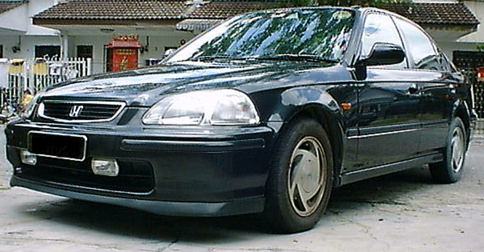
In a strange ironic way, the performance requirements of a family sedan can often be more critical than even that of a sports-car. A DC2 Integra Type-R for e.g. already runs a 200ps B18CR and often seats only the driver or at most an extra passenger. Performance on the road is a given and indeed what is at stake in most situations is probably only the driver's ego. But a family sedan on the other hand is often fully packed with the family. The driver, his wife, his kids, and probably the parents as well will be comfortably seated inside the car (and thus the requirement for a roomy and comfortable interior). Now the stakes are so much more higher. Falter in any situation requiring sufficient power to get out of trouble and what is at stake is not only the driver's ego but the safety of the whole family ! Yes, ironically performance is often most crucial in the family sedan !
The current state of motoring has progressed to the stage that the typical 1.5l car when used with an autobox is now comparatively sluggish on the roads. But things are different with the EK3 Ferio Vi. On the road and against the competition, it is a combination of the high-revving, high power of the 3-stage VTEC D15B and the superb flexibility of the Multimatic gearbox which allows the EK3 to take care of itself ably, even in tight situations or with arrogant drivers - including those with quite a bit larger engines.
I still vividly remember a rather scary encounter against a Toyota Camry 2.2 GX when I first got my EK3. This was the first generation of Camry that was sold here in Malaysia using the 2.2l engine which delivers 130+ps, the large 2200cc displacement endowing the car with very good midrange. He was stuck behind me on a single-lane entry loop into a highway, swerving left and right trying to squeeze through. Indeed if the side of the road had not been lined with ARMCO barriers, I am certain he would have driven onto the grass just to get ahead. Out of a mixture of fear and spite, I changed to 'S' mode and once we were on the main highway, went WOT. Engine rpms immediately shot up to 7000rpm and to my surprise and delight, the EK3 shot forward leaving the Camry cold in its track. It was only after I had slowed down and taking my exit that he finally managed to catch up. Coincidentally he took the same exit so I went WOT again as we exited the highway. Again he couldn't catch up. A traffic light came up next and it was green and by coincidence, again both of us took the tight left hander. Again he catches up and out of spite, I floored it again. This time he couldn't even catch up. I finally slowed down to turn into a parking lot as I had reached my destination. I remember laughing aloud as the Camry came charging past, headlights flashing wildly because I was apparently blocking his road !!
Another interesting episode I had was against a Proton Perdana V6. This uses a 155ps 2.0l V6 engine and is considered by many as a very powerful car - and often driven in such fashion. It was past midnight on an inner city highway and traffic was very sparse so there was plenty of space to run. In the rear-view mirror, I could see the guy weaving in and out very fast, quickly came charging up to my tail. Curiosity quickly got the better of me so as we exited the loop and got onto the main highway, I decided it would be fun to 'test' against this much bally-hooed higher powered car as long as I constantly reminded myself to retain some common sense. 2.0l V6 155ps means it has a 25ps as well as 500cc in displacement advantage over me but my advantage lies in the fact that the Perdana V6 comes only in auto and it's a very heavy car so I would have both MMT's superior flexibility and hopefully a competitive power-to-weight ratio. Still I was driving with two adults in the car while the guy was alone, so as I WOT I also switched off the air-conditioning to get the maximum possible performance. To my surprise, the guy's 25ps advantage was of no avail to him because try as he might, he just couldn't overtake me. Being ahead, I got on WOT earlier than him and was able to quickly pull a small gap and that gap was maintained right up to some rather irresponsible speeds. In the end, I even had time to brake early to enter a tunnel. As both of us exited the tunnel and re-joins the highway, both he & I decided to have a go again. Again all he could do was to keep up with me, unable to close the gap I had pulled ! Eventually we encountered traffic and both of us decided that safety prevails over fun and eased off.
Against a fellow Honda, on one occasion I found I was able to keep ahead of a screaming EG9 on the highway (which I am guessing is an auto). Both our car's bodyweight are similar but the EG9 will have a 25ps advantage (auto B16As generate 155ps) so it was again a rather nice surprise. It was only upon approaching 170kph that the EG9 overtook me and pulled ahead (the EK3 Vi's stock ECU has a built-in ~180kph speed limiter).
Of course no engine-gearbox can be perfect. It still takes a finite amount of time, no matter how short, for the engine to rev up to max power point. Consequently at very low speeds like just after moving off from a standstill and in gentle cruising mode, larger engined and manual cars under ideal conditions can out-run the Multimatic EK3. I have been out-dragged by a Perdana V6 and a manual Proton Satria (coincidentally both with very loud aftermarket exhausts) when both of them wanted to illegaly cut into my lane from a stop junction and a traffic light respectively (their lane was for turning only but they were both using it to jump queue). Such experiences can be annoying of course but in the end a family sedan is not meant to be a drag machine so they have to be accepted as part and parcel of everyday driving.
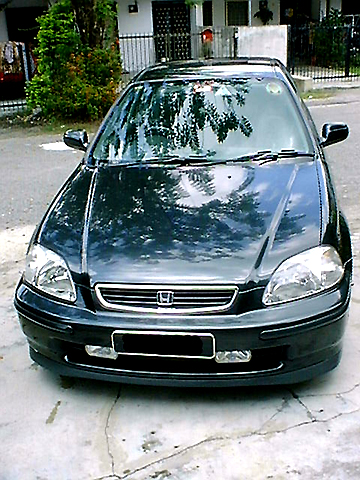
The EK generation is the last generation to retain full multi-link suspension front and back and consequently has great handling and ride. EK3s are equipped with Honda Progressive Valve shocks so their ride comfort can even be compared to the excellent rides of continental cars. This is no mean acheivement since the comfortable superb ride quality is a hallmark of continental cars. As with the engine/gearbox package, the ride quality of the EK3 often took unsuspecting passengers by surprise. In one case my friend Mike from Singapore was impressed enough to spontaneously exclaim to his wife "this is a comfortable car eh ?".
However, there are still some shortcomings. With stock suspension and stock 175/75/13 tyres, there is quite pronounced body-roll during hard cornering. It's a compromise that has to be accepted for the high degree of ride comfort of course. Eventually I had a copy of the EK9 Civic Type-R upper strut bar installed on my EK3. Not initially expecting anything other than sheer asthetic improvement, I was surprised to find the handling of the car to be quite improved, especially the apparent cornering stability (due to the lesser body roll) but ride comfort did degrade to some extent.
With 185/65/14 HR tyres but completely stock suspension, the EK3 is very stable at high speeds. Once when tailing a BMW on the expressway, both of us entered a wide corner at 140kph and surprisingly the EK3 kept up with the BMW with very little drama. When taking very tight corners at the limit, the EK3 will feel very stable and secure even when the tyres have started to screech from understeer. Again there's very little drama to the extent that detractors have labelled the EK3's handling as 'boring'. But let's be sensible. In a family sedan, does it make sense to want an 'exciting' handling with a lot of drama for the sake of 'driving excitement' ? Me, my family's usually in the car and I would much rather have it safe and boring, thank you... Actually, the EK3's cornering limit is really very high. I have followed many cars in tight corners and especially in those with rapidly reducing radius, I have easily closed up to the car in front, only to have to back-off because it had to brake due to over-committing to the corner. However the Ferio Vi is still comparatively a light-weight so passing or being passed by large lorries (trucks) and buses will still cause it to rock very slightly.
In terms of quietness too, the EK Civic have approached equivalent continental car levels. Actually some tyre noise is a given with almost all cars nowadays - indeed even the many BMWs, Volvos, even Mercedes I've driven or sat in surprised me by suffering from this to some extent too. I think the limiting factor nowadays is the rather aggressive tyre designs we have gotten to prefer that compromises noise for performance. In terms of wind noise, there are some intrusion at high speeds. Nevertheless, this would be over critical here because we are talking about speed of 140-160kph, speeds which we rightfully shouldn't be maintaining for long periods of time for the sake of safety.
I wish to conclude this article by touching a little on the much vaunted fuel economy of the 3-stage VTEC D15B. As is constantly hyped, under ideal conditions, the 3-stage VTEC D15B will run in 12V lean-burn mode with air-fuel ratios of ~20:1. The standard fuel economy test conducted in Japan comprises running the car under ideal conditions at a steady 60kph. This is where the EK3 VTi/Vi has been tested to deliver an unheard of mileage of 28km/l ! But of course in practise it's impossible to be driving at a constant 60kph in everyday journeys. My experience with my EK3 is that in a mixture of congested town driving and reasonably free-flowing inner city highway driving (at a ratio of maybe 60 : 40), with several short periods of WOT fun, a consumption of between 12-13km/l can be easily acheived. On long journeys outstation (out of town) on free flowing expressways with relatively easy traffic and sustained speeds of up to 120-140kph, again with regular WOT runs for overtaking slow moving large vehicles, a consumption of up to 16km/l or higher can be acheived. This is with 2 adults in the car too.
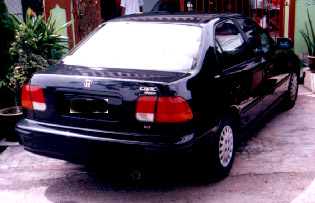
In the end more than with any other engine, the fuel economy that can be acheived with the 3-stage VTEC D15B is dependent on the weight of the right foot and the driving 'exuberence' of the driver. That wonderful green "econo" LED can also be a rather good teacher on economical driving style. To sustain lean-burn mode for long periods of time best results are acheived in cool weather conditions driving in free-flowing traffic. From a standstill at the traffic lights or toll-gate, the key is to get up to cruising speed as fast as possible, a relatively simple feat with the Multimatic. Once up to cruising speed, the key is to maintain a constant speed using very light throttle, keeping the ECONO LED on as much as possuble. Surprisingly this is not as difficult to maintain as might be suspected because with the EK3 Ferio Vi, we can cruise at as high as 120kph (80mph) under this condition ! And with Multimatic, overtaking slower vehicles can be accomplished with relative ease - it's even possible to overtake while in lean-burn mode as long as the extra throttle is applied very gently. Even if the overtaking is done with WOT, lean-burn mode can be restored again very easily after that.
The EK3 Civic/Civic Ferio VTi/Vi remains one of Honda's best overall Civic to this day, even managing to eclipse the current Civic RS in some ways. It is a relatively fast yet economical family car with a degree of comfort approaching equivalent continental models in the same class yet with a high degree of performance.
For selected articles, I am starting a special reader's opinion & feedback feature via our popular vtec.net Forums. For TOVA readers who wishes to give your opinions and feedback on this article, please visit the special thread for this at our TOVA Forums.
Wong KN
March 2003
© Temple of VTEC Asia